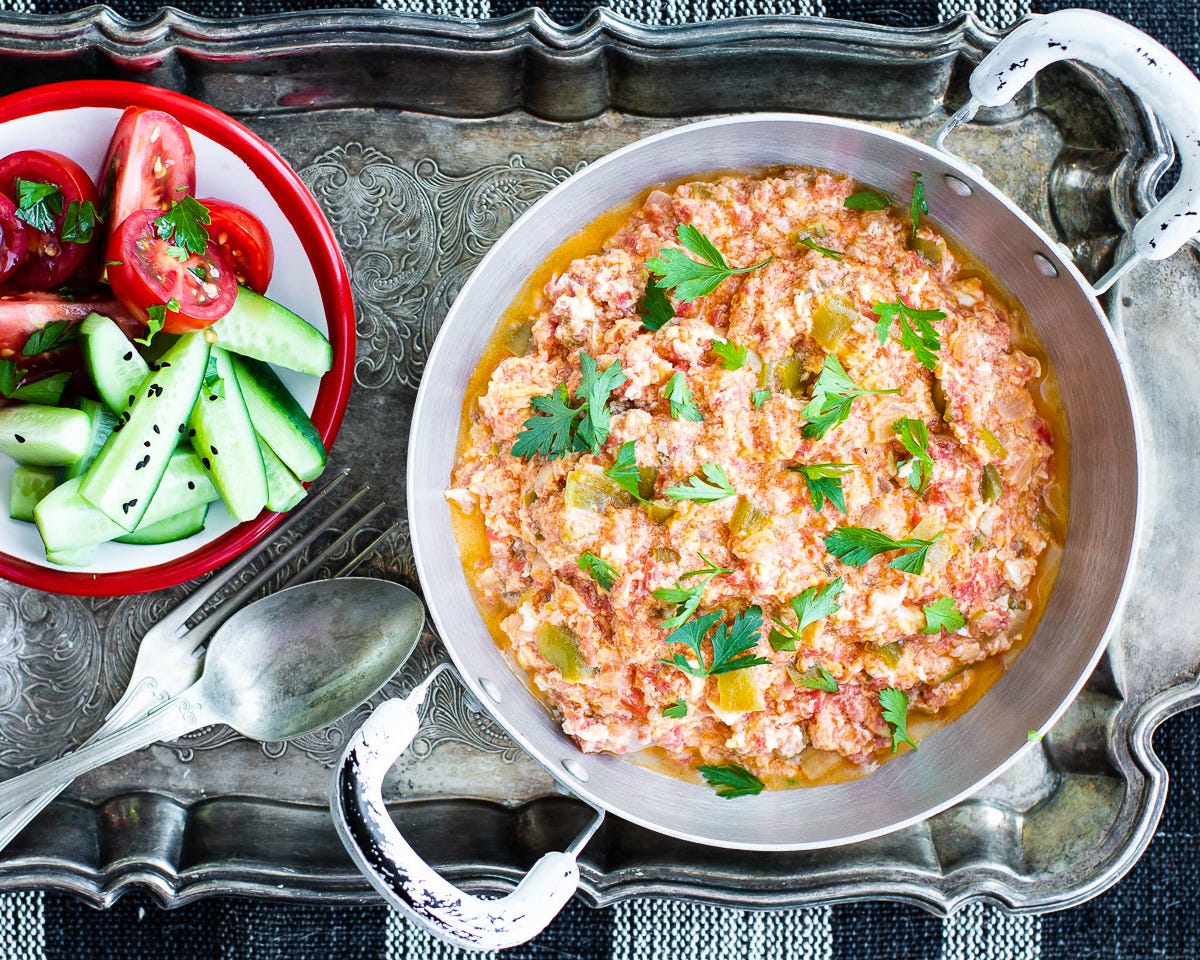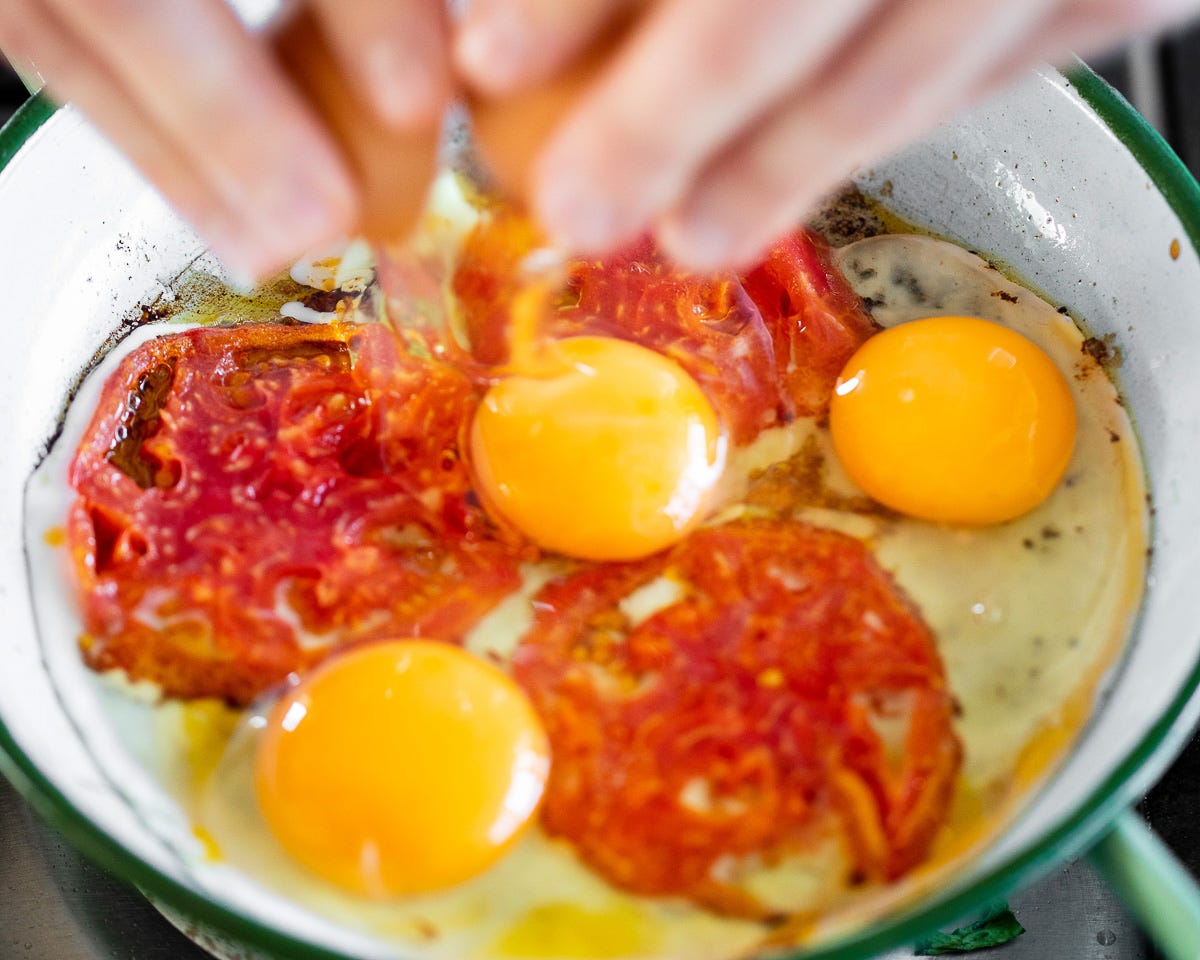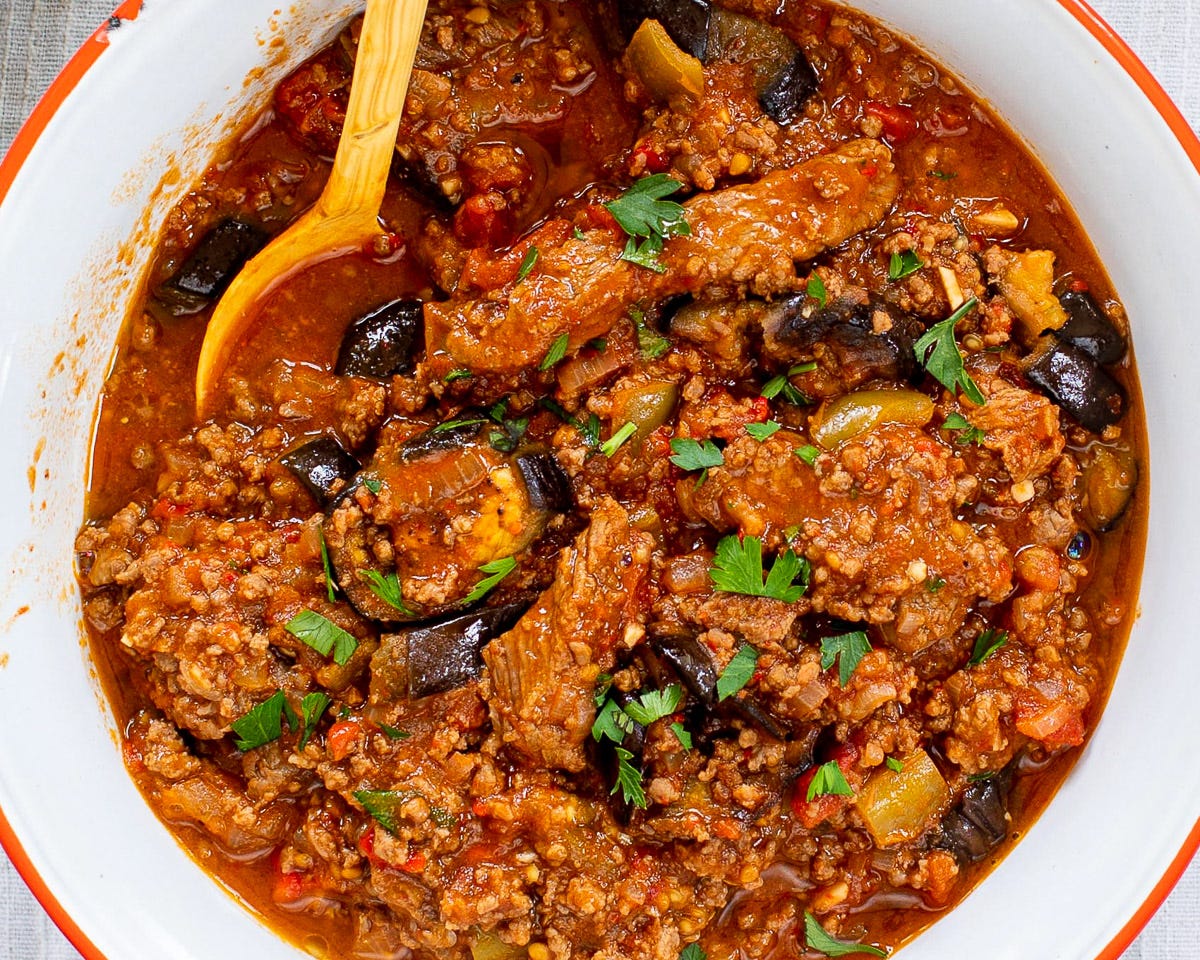Making the most of tomato season
A few tips for using tomatoes this summer, from breakfast to lunch or dinner.
The idea that Turkish tomatoes are sweet and flavourful year-round is surprisingly widespread. Sure, the season here’s longer than if you’re in, say, northern Europe. But they’re still very much a seasonal treat.
Me, I buy my first tomatoes of the year towards the end of May. They’re still not great at that point. But after months of winter fare, I can wait no longer. A month later, I buy as much as I can carry, as often as I can.
This week, I wanted to share with you a few ways I use tomatoes during these precious summer months, from breakfast to dinner. I’m also sharing a few tips for purchasing and storing. And, of course, a few recipes for you to try out.
Let’s get to it!
Breakfast: Simplicity
Most mornings, I cut a tomato and a cucumber of the small, Middle Eastern variety into bite sized pieces. I do very little beyond chopping. A sprinkle of salt and a few drops of extra virgin olive oil, if I feel like it.
It’s not quite a salad, so I don’t go overboard with the oil and never bother with lemon, vinegar or any other acidic ingredients. All I want is a fresh accompaniment to my breakfast, otherwise consisting of eggs, toasted sourdough, cheese and olives. A little honey or jam for that sweet finale.
On weekends, there’s room for a little more adventure.
Turks are big on menemen over the summer period. There’s a recipe on my website, but I’ll give you two extra tips. I now use twice as much tomato as I used to, so feel free to increase the amount of tomatoes if making the recipe. This makes for a saucier, even more delicious version. Second, I stir only the egg whites into the sauce. I only break the yolks and stir them in once the whites are cooked, making sure to serve with the yolks still not quite set for that creamy deliciousness!
When I crave menemen but don’t have the patience for the full thing, I fry eggs on sliced tomatoes. You don’t need a recipe for this – it’s nothing more or less than it sounds like. Simply fry tomato slices in a bit of olive oil (good to use a non-stick pan for this) until they start to soften. Don’t move them. Crack a few eggs on top, then cook until you’re happy with the eggs. For extra flavour, top with feta cheese or za’atar (or both) when serving!
Lunch: Something tomato sauce based
If there’s a big bowl of tomatoes on my kitchen counter, a fresh tomato sauce is usually the starting point of my lunch. When tomatoes are good, they only need a few minutes to turn into a delightful sauce. No need to simmer for hours, or any “canned” taste that needs to be cooked out.
I vary how I prepare them before cooking, but I almost never do the chef-y boiling and ice bath to peel the tomatoes. Too much mess and effort for the home cook, if you ask me. Instead, the stick blender or box grater is my best friend. Quicker in every way. What’s more, it cooks down to a sauce a lot more quickly than chopped tomatoes, too.
If I want chunks and the tomatoes are firm, I use a vegetable peeler to get rid of the skin. If they’re too soft for that, the tomatoes go into the pot in very large chunks, skin on. Once cooked, the skin will separate and can be picked up with tweezers (hence the large chunks, or you’ll be fishing for bits of skin all afternoon).
All about my tomato peeling methods: Four ways to peel tomatoes
But what about the flavours?
I like to start with plenty of (mild) extra virgin olive oil, a couple of garlic cloves and gentle heat. Unless I’m making a classic, long and slow cooked tomato sauce, I rarely bother with onions. If the tomatoes aren’t super flavourful, a teaspoon or two of tomato paste (or red pepper paste!) is a good idea. Chuck it in with the garlic before adding the tomatoes.
Once the tomatoes are in, I up the heat. When they’ve turned sufficiently saucy – usually within a few minutes – I adjust the sweetness and acidity with sugar and a few drops of vinegar or lemon juice, if necessary (both’ll help intensify the flavours in the process). I often add a pinch or two of chili flakes, and sometimes a fresh herb or two, but rarely any spices commonly associated with the Middle East. I prefer my summary tomato sauces not just simple to make, but also simple in flavour, allowing the in season vegetable to shine as it should.
How to use the sauce?
Any way you like, really. It’s incredibly versatile.
Add any combination of 1–3 of legumes, chicken or vegetables. I usually cook any vegetables separately, otherwise they tend to become soft and bland. A few ideas:
As a pasta sauce, topped with feta cheese
Chickpeas or beans in the sauce, fried halloumi to serve
Chicken and red peppers
Roast or fried aubergine (eggplant) or courgette (zucchini) (with or without legumes)
Black olives, roast or fried aubergine (eggplant) and a generous hand of chili, with rice or bread or as a pasta sauce
Dinner: All the options
Summer days in Istanbul are long and hot. A big hot dinner rarely appeals. I prefer something simpler, like pan fried meat or cold vegetable dishes with a generous side salad and perhaps some rice or toasted sourdough.

Like millions of people around the Mediterranean and eastwards, my dinner side salad starts with roughly equal amounts chopped tomato and cucumber. Make sure to sprinkle a little salt on the tomatoes in particular while you prepare the rest. It’ll really help in bringing out flavour. For cucumbers, always use the small, Middle Eastern variety if you can. They’re less watery and a lot more flavourful. If using a long cucumber, make sure to deseed and salt before adding to your salad.
From here on in, the choices depend on what I have to hand and what I feel like.
I like adding a crunchy element. Radishes are my favourite, but peppers or carrots work well, too. Some chopped herbs add freshness. A mixture of parsley and mint is my go-to. Peppery leaves like rocket (aragula) are a great alternative, too. If I have sweeter, leafy greens, I use them as a base, and place my chopped vegetables on top.
I’ve never heard of anyone doing an emulsified dressing for this kind of salad. Just squeeze and drizzle over whatever you fancy. Lemon, lime, pomegranate molasses, vinegar or verjus are all excellent. Individually or paired. Sumac can add an extra layer of zing – particularly excellent if you’re eating something fatty, like grilled meat.
Whatever your choice of acidity: Be generous with the extra virgin olive oil. You don’t need to eat all of it (it’ll mostly sink to the bottom), but it’ll make your salad ten times more moreish than if you’re stingy. Don’t be stingy.
When buying and storing tomatoes
One thing to keep in mind about tomatoes: They thrive at room temperature. In the fridge, not so much. Cold temperatures break down enzymes inside the tomatoes, making them soft and flavourless.
Sure, if you remove them from the fridge and return them to room temperature for a day or so, they won’t be half bad. But if you’re anything like me, you don’t plan that much ahead. And tomatoes straight out of the fridge are never good.
I always buy tomatoes that are stored at room temperature if I can. Once I get home, I keep them that way. Even when my kitchen in Istanbul hits 30°C (86°F), the tomatoes stay on the counter. They’ll last just a day or two, but taste so much better than if I put them in the fridge (where they’ll probably last a week or more).
My recommendation is therefore this: Buy tomatoes often, and in small quantities. Leave them out, but use them as quickly as possible. Check regularly to see if any of them are getting mushily soft spots, in which case discard that tomato and come up with a use for the rest asap.
Personally, I buy tomatoes at least every other day when in season. Just like I do tender fruits like cherries or apricots (tomatoes are technically fruits, after all).
A final reminder: Tomatoes are extremely seasonal. Outside of season – summer and early autumn, though the length of the season will vary significantly depending on your local climate – use canned tomatoes. Or do like me and get huge batches of sauce friendly tomatoes like San Marzano towards the end of the season, cook them down and store in the freezer or in jars, for use throughout the darker half of the year.
Here’s a few ways to use tomatoes this season:
Menemen (Eggs in tomato sauce)
The ultimate Turkish breakfast item – better even than what’s become known as “Turkish eggs”. Basically eggs braised in tomato sauce, I could eat any version of this for breakfast every day.
Çoban salatası (Turkish chopped salad)
I say Turkish chopped salad, but that’s only because this recipe is based on how it’s typically eaten in Turkey. Versions of the same salad abound across the Middle East and I’m not sure that one cuisine owns it more than any other.
Musakka (Turkish moussaka)
I know I said I prefer simple, non-stew dinners in summer, but I make an exception for this, the Turkish version of moussaka. (If you weren’t aware, moussaka exists in different versions in multiple cuisines, the Greek version being but the latest addition to a family of dishes). Simpler than its Greek cousin, this is basically the marriage of tomatoes, aubergines and meat. Delicious!
Orzo pasta with fresh tomatoes and feta yoghurt
This is a version of a recipe I found in the cookbook for Ducksoup, one of London’s more interesting restaurants. It makes brilliant use of fresh tomatoes. Make it this summer.
Tomato salad with purple basil
Tomatoes don’t need cucumbers to make a great salad, of course. This was my daily go to a few summers ago, and I still make it a lot. So simple, but so tasty! If you can’t get purple basil, use regular.
Gavurdağ salatası (Turkish tomato & walnut salad)
I always order this salad at kebab restaurants. Everyone makes it differently, this is how I prefer it.
🔜 Coming this weekend for paying subscribers:
Chickpeas & bread in fresh tomato sauce
The result of making a quick, humble dish out of what I had to hand, I immediately wrote down the recipe after eating it. Since, I’ve made it many times more.
This recipe will be a bonus recipe for paying subscribers, who will get it over the weekend.

















